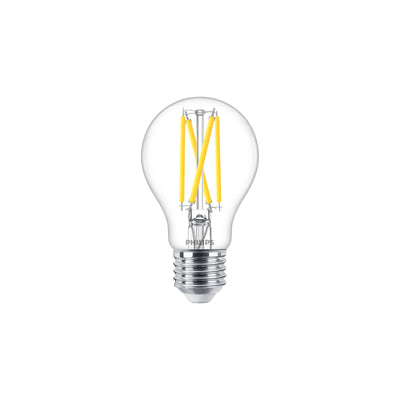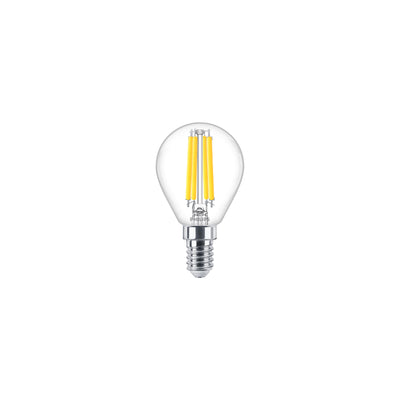Rotary Sockets
Rotary sockets, known as Edison screw sockets, have been a widely used standard in lighting for decades. The most common types are E14 and E27, recognizable by the letter 'E' for Edison and the number indicating the diameter in millimeters. These lamps are widely applicable in domestic environments, but also in commercial or decorative fixtures.
-

Philips Philips LED bulb 806 lumen E27 2200K-2700K CRI 95 dimmable A60 300°
3,5W - 470 lm - 4000K - Dimbaar16,46 -

Philips Philips CorePro LED bulb A60 E27 13W 3000K 1521 lumen non-dimmable energy efficient
3,5W - 470 lm - 4000K - Dimbaar2,85 -

Philips Philips CorePro LEDbulb 8W E27 3000K warm white light
3,5W - 470 lm - 4000K - Dimbaar2,50 -

Philips Philips CorePro LED bulb 4.9W E27 2700K 470 lumen warm white light
3,5W - 470 lm - 4000K - Dimbaar2,95 -

Philips Philips 3.4W LED bulb E27 A60 warm white 2700K 470 lumen
3,5W - 470 lm - 4000K - Dimbaar2,95 -

Philips Philips E27 LED bulb 2700K 470 lumens dimmable A60 energy efficient long lifespan
3,5W - 470 lm - 4000K - Dimbaar4,95 -

Philips Philips LED bulb e27 470 lumen 2700K dimmable warm white P45
3,5W - 470 lm - 4000K - Dimbaar3,95 -

Philips Philips mas vle ledlusterD E14 P45 2700K dimmable bulb 470 lumen
3,5W - 470 lm - 4000K - Dimbaar2,95 -

Philips Philips LED candle bulb E14 B35 warm white 2700K with 470 lumen output
3,5W - 470 lm - 4000K - Dimbaar3,50 -

Philips Philips MAS VLE LED bulb D5.9-60W E27 G120CLG 2700K warm white dimmable
3,5W - 470 lm - 4000K - Dimbaar9,95 -

Philips Philips LED bulb E27 927 A60 2700K warm white 1521 lumen
3,5W - 470 lm - 4000K - Dimbaar5,95 -

Philips Philips LED bulb D7.8-75W E27 2700K warm white for energy-efficient lighting
3,5W - 470 lm - 4000K - Dimbaar4,49
Switching to LED Rotary Sockets: Savings and Sustainability
Replacing traditional incandescent or halogen bulbs with an E14 or E27 fitting by LED variants offers significant advantages. LED bulbs are known for their high energy efficiency and long lifespan. A switch can lead to energy savings of up to 90% compared to older lighting.
- High energy savings: LED bulbs consume a fraction of the energy needed by incandescent bulbs to provide the same light output. This results in noticeably lower energy costs.
- Long lifespan: An LED E14 or E27 bulb can last up to 15 to 25 times longer than a traditional incandescent bulb, reducing the frequency of replacement and maintenance costs.
- Environmentally conscious choice: LED bulbs contain no mercury, making them safer for use and recycling. They also contribute to reduced CO2 emissions.
- Instant light: Unlike some older lamps, LED bulbs provide full brightness immediately upon switching on.
Comparing Lumens and Wattage when Choosing LED
When choosing an LED replacement for your current incandescent bulb, focus not on the wattage of the LED bulb itself, but on the Lumens (light output) and the wattage that the LED bulb replaces. The Lumen value indicates how bright a bulb shines.
| Wattage old incandescent bulb | LED Lumen value |
|---|---|
| 15W | 130 - 160 lm |
| 25W | 220 - 250 lm |
| 40W | 400 - 470 lm |
| 60W | 700 - 800 lm |
| 75W | 1000 - 1050 lm |
| 100W | 1500 - 1600 lm |
The Differences Between E14 and E27 Sockets
The main difference between an E14 and an E27 bulb is the diameter of the socket, the screw thread that fits into the fixture.
| Socket | Diameter | Special feature |
|---|---|---|
| E14 | 14 millimeters | Also known as 'small socket.' |
| E27 | 27 millimeters | Also known as 'large socket.' |
An E27 bulb won't fit into a fixture with an E14 socket, and vice versa. Therefore, pay close attention to the label on your current bulb or fixture when purchasing.
[Image: Clear visual comparison of an E14 and E27 socket, with diameter indication]

Choose the Right Light Color (Kelvin) for Your Space
The color temperature of a lamp, expressed in Kelvin (K), determines the ambiance and functionality of the light. A lower Kelvin value stands for warmer, yellower light, while a higher value stands for cooler, whiter light.
| Kelvin (K) | Light Color | Application |
|---|---|---|
| 1800-2200K | Extra warm white (candlelight) | Atmospheric environments, such as hospitality, living rooms, and bedrooms. |
| 2700K | Warm white | Homely atmosphere, comparable to traditional incandescent bulbs. |
| 3000K | Neutral warm white | General areas, corridors, reception areas. |
| 4000K | Cool white | Workspaces, kitchens, offices, schools where concentration is desired. |
| 6500K | Daylight white | Spaces where bright, accurate light is needed, such as workshops or laboratories. |
Forms and Styles of E14 and E27 Bulbs
Although the sockets are standardized, E14 and E27 bulbs are available in a variety of shapes and styles. This diversity allows you to choose the bulb that not only functions well but also contributes to the look of your fixture and interior.
- Candle bulb: This elegant shape, often with clear or frosted glass and sometimes a curved tip, is popular in chandeliers and decorative fixtures.
- Pear shape: The classic, traditional bulb shape that fits many general lighting applications.
- Ball or golf ball shape: A more compact, round shape that fits well in smaller fixtures or as a decorative bulb.
- Globe bulb: A larger, bulbous lamp often used as a decorative focal point in open fixtures.
- Reflector lamp (PAR or R-shape): These lamps have a built-in reflector and direct the light in a specific beam, making them suitable for accent lighting.
- Filament lamps: These LED bulbs mimic the appearance of traditional filaments, often with clear glass. They offer a warm, decorative light.
[Image: Collage of different bulb shapes (candle, pear, ball, globe, reflector, filament) with E14 and E27 sockets]

Dimmable and Smart Rotary Sockets: More Control Over Your Lighting
Modern E14 and E27 LED bulbs often offer more than just on/off functionality. Dimmable options and smart lighting provide you with extra control over ambiance and energy consumption.
Dimmable Bulbs and Dim to Warm Technology
Many E14 and E27 LED bulbs are dimmable, allowing you to adjust the light intensity as desired. This contributes to energy savings, as the bulb consumes less power when dimmed. For dimming LED bulbs, a suitable LED dimmer is necessary.
Some dimmable LED bulbs feature 'Dim to Warm' technology. When dimming, not only the brightness is reduced but the color temperature also changes. A warm white light of 2700K can then gradually change to an extra warm white, such as 2200K, creating a cozier atmosphere.
Smart Lighting for E27 Sockets
For E27 sockets, smart LED bulbs are also available. These bulbs offer extensive functionalities, such as remote control via smartphone app or tablet. You can adjust the light color (RGB or tunable white) and intensity, set timers, and even link the lighting to voice assistants like Google Home or Amazon Alexa. This enhances comfort and possibilities for creating different lighting scenarios.
Replacing an E14 or E27 Lamp, You Can Do It Easily
Replacing a lamp with an E14 or E27 rotary socket is a straightforward process you can do yourself. Always check that the power is turned off before installation.
To replace your old incandescent bulb with an LED variant:
- Turn off the power to the fixture in question via the light switch or with the group switch in the fuse box.
- Carefully unscrew the old bulb from the fixture.
- Check the fitting (E14 or E27) of the new LED bulb and ensure it matches the fixture.
- Screw the new LED bulb clockwise into the fixture until it is securely in place.
- Turn the power back on and check the operation of the bulb.











